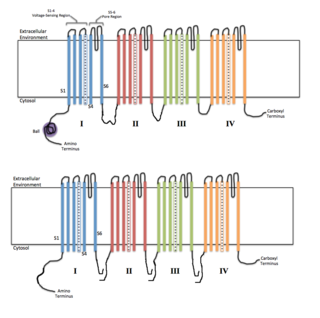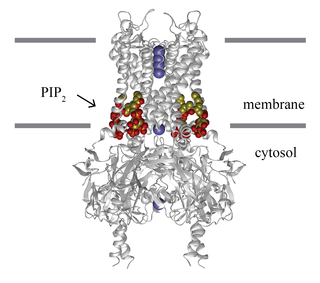Related Research Articles

Ion channels are pore-forming membrane proteins that allow ions to pass through the channel pore. Their functions include establishing a resting membrane potential, shaping action potentials and other electrical signals by gating the flow of ions across the cell membrane, controlling the flow of ions across secretory and epithelial cells, and regulating cell volume. Ion channels are present in the membranes of all cells. Ion channels are one of the two classes of ionophoric proteins, the other being ion transporters.

Potassium channels are the most widely distributed type of ion channel and are found in virtually all living organisms. They form potassium-selective pores that span cell membranes. Potassium channels are found in most cell types and control a wide variety of cell functions.

Voltage-gated ion channels are a class of transmembrane proteins that form ion channels that are activated by changes in the electrical membrane potential near the channel. The membrane potential alters the conformation of the channel proteins, regulating their opening and closing. Cell membranes are generally impermeable to ions, thus they must diffuse through the membrane through transmembrane protein channels. They have a crucial role in excitable cells such as neuronal and muscle tissues, allowing a rapid and co-ordinated depolarization in response to triggering voltage change. Found along the axon and at the synapse, voltage-gated ion channels directionally propagate electrical signals. Voltage-gated ion-channels are usually ion-specific, and channels specific to sodium (Na+), potassium (K+), calcium (Ca2+), and chloride (Cl−) ions have been identified. The opening and closing of the channels are triggered by changing ion concentration, and hence charge gradient, between the sides of the cell membrane.

Inward-rectifier potassium channels (Kir, IRK) are a specific lipid-gated subset of potassium channels. To date, seven subfamilies have been identified in various mammalian cell types, plants, and bacteria. They are activated by phosphatidylinositol 4,5-bisphosphate (PIP2). The malfunction of the channels has been implicated in several diseases. IRK channels possess a pore domain, homologous to that of voltage-gated ion channels, and flanking transmembrane segments (TMSs). They may exist in the membrane as homo- or heterooligomers and each monomer possesses between 2 and 4 TMSs. In terms of function, these proteins transport potassium (K+), with a greater tendency for K+ uptake than K+ export. The process of inward-rectification was discovered by Denis Noble in cardiac muscle cells in 1960s and by Richard Adrian and Alan Hodgkin in 1970 in skeletal muscle cells.

Voltage-gated potassium channels (VGKCs) are transmembrane channels specific for potassium and sensitive to voltage changes in the cell's membrane potential. During action potentials, they play a crucial role in returning the depolarized cell to a resting state.

Potassium voltage-gated channel, Shab-related subfamily, member 1, also known as KCNB1 or Kv2.1, is a protein that, in humans, is encoded by the KCNB1 gene.

Potassium channel subfamily K member 2 is a protein that in humans is encoded by the KCNK2 gene.

Potassium channel subfamily K member 3 is a protein that in humans is encoded by the KCNK3 gene.

Potassium channel subfamily K member 1 is a protein that in humans is encoded by the KCNK1 gene.

Potassium channel subfamily K member 9 is a protein that in humans is encoded by the KCNK9 gene.

Potassium channel subfamily K member 4 is a protein that in humans is encoded by the KCNK4 gene. KCNK4 protein channels are also called TRAAK channels.

Potassium channel subfamily K member 6 is a protein that in humans is encoded by the KCNK6 gene.

Potassium channel subfamily K member 5 is a protein that in humans is encoded by the KCNK5 gene.

Potassium channel, subfamily K, member 7, also known as KCNK7 or K2P7.1 is a protein which is encoded in humans by the KCNK7 gene. K2P7.1 is a potassium channel containing two pore-forming P domains. Multiple transcript variants encoding different isoforms have been found for this gene.

Potassium channel, subfamily K, member 10, also known as KCNK10 is a human gene. The protein encoded by this gene, K2P10.1, is a potassium channel containing two pore-forming P domains.

Potassium channel, subfamily K, member 13, also known as KCNK13 is a human gene. The protein encoded by this gene, K2P13.1 is a potassium channel containing two pore-forming P domains.

Potassium channel subfamily K member 16 is a protein that in humans is encoded by the KCNK16 gene. The protein encoded by this gene, K2P16.1, is a potassium channel containing two pore-forming P domains.

Potassium channel subfamily K member 18 (KCNK18), also known as TWIK-related spinal cord potassium channel (TRESK) or K2P18.1 is a protein that in humans is encoded by the KCNK18 gene. K2P18.1 is a potassium channel containing two pore-forming P domains.
A potassium channel opener is a type of drug which facilitates ion transmission through potassium channels.

Lq2 is a component of the venom of the scorpion Leiurus quinquestriatus. It blocks various potassium channels, among others the inward-rectifier potassium ion channel ROMK1.
References
- 1 2 Goldstein SA, Bayliss DA, Kim D, Lesage F, Plant LD, Rajan S (Dec 2005). "International Union of Pharmacology. LV. Nomenclature and molecular relationships of two-P potassium channels". Pharmacological Reviews. 57 (4): 527–40. doi:10.1124/pr.57.4.12. PMID 16382106. S2CID 7356601.
- ↑ "Two P domain potassium channels". Guide to Pharmacology . Retrieved 2019-05-28.
- ↑ Rang, HP (2003). Pharmacology (8 ed.). Edinburgh: Churchill Livingstone. p. 59. ISBN 978-0-443-07145-4.
- ↑ Gutman GA, Chandy KG, Adelman JP, Aiyar J, Bayliss DA, Clapham DE, et al. (Dec 2003). "International Union of Pharmacology. XLI. Compendium of voltage-gated ion channels: potassium channels". Pharmacological Reviews. 55 (4): 583–6. doi:10.1124/pr.55.4.9. PMID 14657415. S2CID 34963430.
- 1 2 3 4 5 6 7 8 9 10 11 12 13 Enyedi P, Czirják G (Apr 2010). "Molecular background of leak K+ currents: two-pore domain potassium channels". Physiological Reviews. 90 (2): 559–605. doi:10.1152/physrev.00029.2009. PMID 20393194.
- 1 2 3 4 5 6 7 8 9 10 11 12 13 Lotshaw DP (2007). "Biophysical, pharmacological, and functional characteristics of cloned and native mammalian two-pore domain K+ channels". Cell Biochemistry and Biophysics . 47 (2): 209–56. doi:10.1007/s12013-007-0007-8. PMID 17652773. S2CID 12759521.
- ↑ Fink M, Lesage F, Duprat F, Heurteaux C, Reyes R, Fosset M, Lazdunski M (Jun 1998). "A neuronal two P domain K+ channel stimulated by arachidonic acid and polyunsaturated fatty acids". The EMBO Journal. 17 (12): 3297–308. doi:10.1093/emboj/17.12.3297. PMC 1170668 . PMID 9628867.
- ↑ Goldstein SA, Bockenhauer D, O'Kelly I, Zilberberg N (Mar 2001). "Potassium leak channels and the KCNK family of two-P-domain subunits". Nature Reviews. Neuroscience. 2 (3): 175–84. doi:10.1038/35058574. PMID 11256078. S2CID 9682396.
- ↑ Sano Y, Inamura K, Miyake A, Mochizuki S, Kitada C, Yokoi H, Nozawa K, Okada H, Matsushime H, Furuichi K (Jul 2003). "A novel two-pore domain K+ channel, TRESK, is localized in the spinal cord". The Journal of Biological Chemistry. 278 (30): 27406–12. doi: 10.1074/jbc.M206810200 . PMID 12754259.
- ↑ Czirják G, Tóth ZE, Enyedi P (Apr 2004). "The two-pore domain K+ channel, TRESK, is activated by the cytoplasmic calcium signal through calcineurin". The Journal of Biological Chemistry. 279 (18): 18550–8. doi: 10.1074/jbc.M312229200 . PMID 14981085.